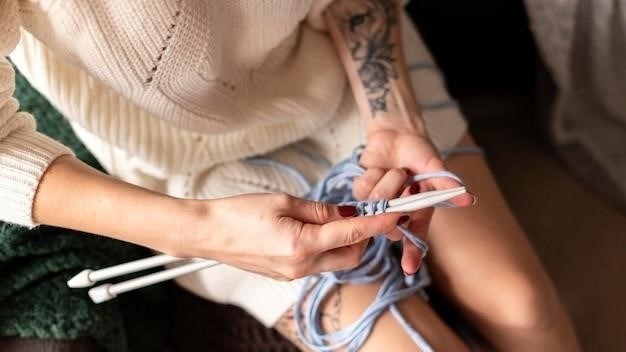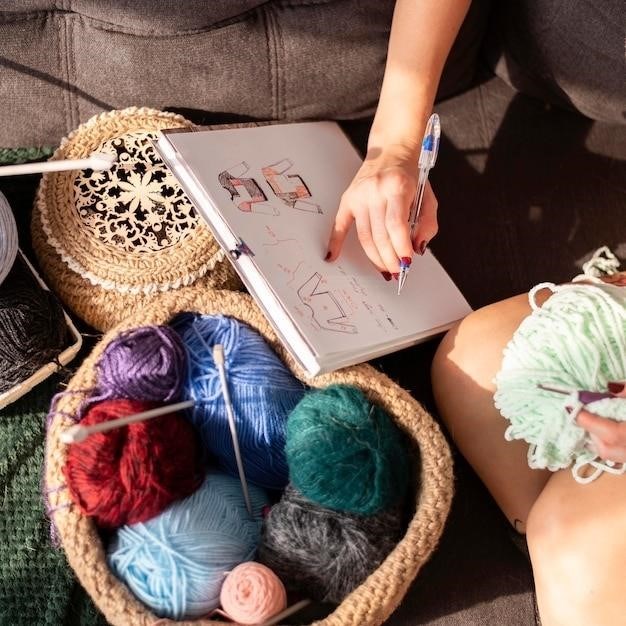Understanding Crochet Pattern PDFs
Navigating crochet pattern PDFs requires understanding their structure․ These documents typically include a key explaining symbols and abbreviations‚ crucial for interpreting the instructions․ Charts‚ either row-by-row or round‚ provide visual representations of the stitches․ Mastering these elements unlocks successful project completion․
Decoding the Pattern Key
The pattern key is your Rosetta Stone for understanding crochet symbols and abbreviations․ It’s usually found at the beginning of a PDF pattern and acts as a legend․ Each symbol represents a specific crochet stitch‚ like a chain (ch)‚ single crochet (sc)‚ double crochet (dc)‚ or treble crochet (tr)․ Abbreviations are shortened versions of these stitch names‚ saving space and making the pattern easier to read․ Pay close attention to the key‚ as different designers may use slightly varying symbols or abbreviations․ Familiarize yourself with standard crochet symbols‚ but always prioritize the key provided in your specific PDF pattern․ This ensures accuracy and prevents misunderstandings․ Take your time deciphering the key; it’s the foundation for successful project execution․ Understanding the key is fundamental to successful crochet from a PDF pattern․ Don’t skip this crucial step!
Identifying Common Crochet Symbols
While pattern keys are essential‚ familiarity with common crochet symbols accelerates the reading process․ Many patterns utilize standardized symbols adopted by organizations like the Craft Yarn Council․ These symbols visually represent stitches‚ making charts and instructions easier to follow․ A common symbol is a small ‘x’ often representing a single crochet (sc)․ A taller‚ more elongated symbol might represent a double crochet (dc)‚ while a still taller symbol could indicate a treble crochet (tr)․ Circles‚ squares‚ and other shapes might represent increases or decreases‚ or specific stitch patterns․ While some variations exist‚ understanding basic shapes and their general meanings provides a significant advantage․ Reference charts online or in crochet books for a visual guide․ Recognizing these common symbols speeds up your pattern reading significantly and aids in comprehension․
Understanding Stitch Abbreviations
Beyond symbols‚ crochet patterns frequently use abbreviations for stitches․ These shorthand notations save space and improve readability․ Common abbreviations include “sc” for single crochet‚ “dc” for double crochet‚ and “tr” for treble crochet․ You’ll also encounter abbreviations for chains (ch)‚ slip stitches (sl st)‚ and various special stitches․ Regional variations exist; for example‚ UK terminology might differ slightly from US terminology․ The pattern key usually clarifies these abbreviations‚ providing a complete list with their corresponding stitch descriptions․ However‚ familiarizing yourself with common abbreviations beforehand significantly improves reading speed․ Online resources and crochet dictionaries offer comprehensive lists‚ helping you master these essential shorthand notations and understand how they translate into the actual stitches․
Working with Crochet Charts
Crochet charts offer a visual alternative to written instructions․ Understanding how to read row-by-row and round charts is key to successful projects․ Each symbol represents a stitch‚ creating a visual guide for your crochet work․
Reading Row-by-Row Charts
Row-by-row crochet charts present each row of your project as a separate line of symbols․ These charts are read from left to right‚ and each symbol corresponds to a specific stitch․ The chart typically shows the right side of the work‚ so you’ll be following the symbols across each row to complete the pattern․ Look for a key or legend within the PDF to understand what each symbol represents (e․g․‚ chain‚ single crochet‚ double crochet‚ etc․)․ Pay close attention to the number of rows specified in the pattern‚ ensuring you complete all rows before moving to the next section․ Some charts may include additional symbols indicating increases‚ decreases‚ or other special stitches․ Refer to the pattern’s key to understand these special instructions․ Remember to count your stitches carefully as you work to ensure your project matches the chart․ If you lose your place‚ carefully examine the chart and the completed rows to identify your location and continue․ Practicing with simpler charts is a great way to build your confidence and understanding before moving on to more complex patterns․ Careful attention to detail will ensure a successful crochet project․ Accurate row counting is paramount; double check to avoid errors that may appear later․
Interpreting Round Charts
Round charts‚ unlike row-by-row charts‚ depict each round of your crochet project as a circle or spiral of symbols․ This visual representation is particularly useful for creating items like amigurumi or circular motifs․ To read a round chart‚ begin at a designated starting point‚ often marked with a symbol or instruction in the pattern’s key․ Follow the symbols around the circle‚ completing each stitch as indicated․ Unlike row-by-row charts where you read left to right‚ you’ll be working in a continuous circular motion․ The pattern may indicate increases or decreases in specific rounds to shape the item․ Pay close attention to these instructions as they are essential for achieving the desired form․ Numbered rounds are clearly marked‚ allowing you to track your progress․ Refer to the accompanying pattern key to understand the meaning of each symbol․ For example‚ a symbol might represent a single crochet‚ double crochet‚ or a special stitch․ Accurate stitch counts are crucial; count stitches within each round to maintain the intended dimensions and avoid errors․ Consistent attention will yield a well-formed and accurately sized piece․ Always double-check your stitch count to maintain accuracy․
Understanding Chart Symbols
Crochet charts utilize symbols to represent various stitches‚ significantly simplifying complex patterns․ A pattern’s key is essential; it acts as a legend translating each symbol into its corresponding stitch․ Common symbols include those for chain stitches (ch)‚ slip stitches (sl st)‚ single crochet (sc)‚ double crochet (dc)‚ and treble crochet (tr)․ More intricate stitches may have unique symbols․ The key often includes abbreviations alongside the symbols‚ aiding comprehension․ For example‚ “sc” might be paired with a symbol resembling a small “x․” Charts frequently use color-coding; this visual cue aids in differentiating stitch types or yarn colors․ Understanding color-coding is crucial for accurate stitch placement‚ especially in multi-colored projects․ Some patterns employ additional symbols for increases‚ decreases‚ or special techniques․ These symbols are always explained in the pattern’s key․ Familiarity with standard crochet symbols‚ combined with careful attention to the pattern’s key‚ is paramount for successful chart interpretation․

Essential Tools and Techniques
Efficient PDF readers‚ printing for annotations‚ and effective page management are crucial for successful crochet pattern interpretation․ These tools streamline the process and enhance understanding․
Using a PDF Reader Effectively
Choosing the right PDF reader is paramount for a smooth crocheting experience․ Many free and paid options exist‚ each offering varying functionalities․ Consider features like zoom capabilities for detailed stitch viewing‚ annotation tools for marking progress and noting personal adjustments‚ and the ability to easily navigate between pages․ A reader with a robust search function can prove invaluable when quickly referencing abbreviations or specific instructions within lengthy patterns․ Furthermore‚ the ability to adjust brightness and contrast can significantly improve readability‚ especially for intricate designs or patterns printed on less-than-ideal paper․ Some readers allow for text reflow‚ potentially making reading easier on smaller screens․ Ensure your chosen reader supports these features for optimal pattern comprehension and a more enjoyable crocheting process․ Don’t underestimate the impact of a well-chosen PDF reader on your crafting workflow; it’s an often-overlooked yet critical tool․
Printing and Annotating Patterns
While digital viewing is convenient‚ printing your crochet pattern offers tangible advantages․ A printed copy allows for easy annotation‚ crucial for tracking progress‚ making notes‚ and highlighting potentially confusing sections․ Choose a printer capable of producing clear‚ high-resolution output to ensure readability of small symbols and text․ Consider using high-quality paper to prevent ink bleeding or smudging‚ which can obscure vital details․ Utilize colored highlighters or pencils to mark completed rows or sections‚ making it easier to monitor your progress and avoid losing your place․ Don’t hesitate to add personal notes‚ stitch counts‚ or reminders directly onto the printout; This hands-on approach fosters a clearer understanding of the pattern and aids in identifying and correcting potential errors․ Remember to always keep a backup digital copy of your pattern‚ safeguarding against accidental damage or loss of your printed version․
Managing Multiple Pattern Pages
Many crochet patterns span several pages‚ demanding efficient management techniques․ Avoid the frustration of constantly flipping through pages by using page markers or sticky notes to quickly locate specific instructions․ Consider printing double-sided to conserve paper and minimize page-turning․ Alternatively‚ organize digital pages using PDF annotation tools‚ highlighting key sections or adding bookmarks for easy navigation․ For complex projects‚ creating a separate notebook to record notes‚ stitch counts‚ and progress tracking is highly beneficial․ This dedicated space allows for a clear overview of your work‚ reducing confusion and enhancing efficiency․ If using a tablet or computer‚ utilize the zoom function to enlarge sections for better visibility of intricate details or small text․ These strategies contribute to a smoother‚ more organized crochet experience‚ reducing potential errors stemming from page-flipping or misinterpretations․

Troubleshooting Common Issues
Encountering unclear symbols or gauge inconsistencies? Don’t panic! Online resources and crochet communities offer invaluable support․ Seek clarification on ambiguous instructions and learn to adjust for variations in tension․
Dealing with Ambiguous Symbols
Occasionally‚ crochet pattern PDFs may contain symbols that are unclear or not immediately recognizable․ This is where a methodical approach becomes crucial․ First‚ carefully examine the pattern’s key; many keys provide visual representations of common stitches alongside their abbreviations․ If the symbol remains ambiguous after checking the key‚ consider these steps⁚ Consult online crochet resources․ Numerous websites and forums dedicated to crochet offer extensive symbol dictionaries and explanations․ A simple image search often yields results clarifying unfamiliar symbols․ If the symbol is still uncertain after online research‚ consider contacting the pattern designer or posting a query in a crochet community forum․ Experienced crocheters are often happy to assist with deciphering puzzling symbols․ Remember‚ persistence is key; don’t let a single ambiguous symbol derail your project․ With a little detective work‚ you can usually solve the mystery and continue crafting․
Understanding Gauge and Tension
Gauge‚ in crochet‚ refers to the number of stitches and rows per inch (or centimeter) you create using a specific yarn and hook size․ Tension‚ closely related‚ describes the tightness or looseness of your stitches․ Accurate gauge is paramount for ensuring your finished project matches the pattern’s intended dimensions․ Pattern PDFs usually specify the required gauge; achieving this is crucial for success․ Before starting your project‚ create a gauge swatch⁚ a small sample of the pattern’s stitch(es)․ Compare your swatch’s dimensions to the pattern’s gauge specifications․ If they don’t match‚ adjust your hook size (larger hook for looser gauge‚ smaller for tighter) or yarn weight to achieve the correct gauge․ Remember‚ consistent tension is equally important․ Inconsistent tension leads to uneven fabric and may significantly alter the final dimensions of your project․ Practice maintaining even tension throughout your work‚ creating a consistent fabric․
Correcting Mistakes in Crochet
Even experienced crocheters make mistakes! Identifying errors early is key․ Carefully compare your work to the pattern’s instructions‚ row by row․ A crochet hook with a slightly smaller size than your working hook can be helpful for gently unraveling mistakes․ For dropped stitches‚ use a crochet hook or a tapestry needle to carefully pick up the dropped stitches and re-insert them into the work․ For incorrect stitches‚ unravel back to the point of the error and redo that section․ Don’t be afraid to frog (rip out) your work if necessary; it’s better than continuing with an irreparable error․ When working with intricate patterns‚ consider using stitch markers to keep track of your progress and identify the location of mistakes more quickly․ Remember‚ patience is crucial․ Take your time‚ and don’t get discouraged by errors․ Learning to correct mistakes is part of the crochet learning process․


